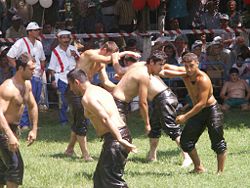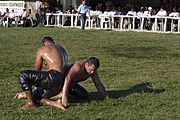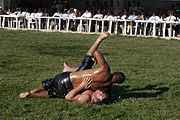- Oil wrestling
-
"Pehlivan" redirects here. For the 1984 Turkish film, see Pehlivan (film)."Yagli" redirects here. For the racehorse, see Yagli (horse).
Oil wrestling or Yağlı Güreş
Oil wrestling tournament in IstanbulAlso known as Turkish Wrestling Focus Wrestling Country of origin Turkey Olympic sport No Oil wrestling (Turkish: yağlı güreş), also called grease wrestling, is the Turkish national sport. It is so called because the wrestlers douse themselves with olive oil. It is related to the Uzbeki kurash, Tuvan khuresh and Tatar köräş. The wrestlers, known as pehlivan (from Persian پهلوان or pehlevān, meaning "hero" or "champion") wear a type of hand-stitched lederhosen called a kisbet (sometimes kispet), which is traditionally made of water buffalo hide, and most recently has been made of calfskin.
Unlike Olympic wrestling, oil wrestling matches may be won by achieving an effective hold of the kisbet. Thus, the pehlivan aims to control his opponent by putting his arm through the latter's kisbet. To win by this move is called paça kazık. Originally, matches had no set duration and could go on for one or two days until one man was able to establish his superiority, but in 1975 the duration was capped at 40 minutes for the baspehlivan[clarification needed] and 30 minutes for the pehlivan category. If there is no winner, play continues for another 15 minutes—10 minutes for the pehlivan category, wherein scores are kept to determine the victor.
The annual Kırkpınar tournament, held in Edirne in Turkish Thrace since 1362, is the oldest continuously running, sanctioned sporting competition in the world.[citation needed] Oil wrestling festivals also take place in northern Greece in the Eastern Macedonia (Serres region) and West Thrace (Rhodope Mountains).[1][2][3][4] In recent years, this style of wrestling has also become popular in other countries, particularly the Netherlands and Japan.
Contents
History
Cognate forms of Turkic folk wrestling are found throughout Central Asia under the names Köraş, Khuresh, Kurash, etc.
Turkish wrestlers started covering themselves according to Islamic law (between the navel and the knees) after the 10th century.[citation needed] After the Oghuz branch of Turks migrated to Western Asia and Anatolia, they brought their Central Asian Kurash wrestling style with them. After the conquest of Anatolia by Seljuk Turks, they introduced the traditional freestyle wrestling called karakucak (literally "black hug") and the special leather clothing and initiated using olive oil to make it harder to grip one's opponent, from the ancient Western Asian wrestling;[citation needed] and created what is today known as Yağlı Güreş or Turkish oil wrestling. In the Ottoman Empire, wrestlers learned the art in special schools called تکیه tekke, which were not merely athletic centres, but also spiritual centres
Wrestlers oil one another prior to matches as a demonstration of balance and mutual respect. If a man defeats an older opponent, he kisses the latter's hand (a sign of respect for elders in Turkey).
Matches are held all over Turkey throughout the year, but in early summer, around 1000 competitors gather in Kırkpınar for an annual three-day wrestling tournament to determine who will be the baspehlivan ("chief wrestler") of Turkey. Ottoman chroniclers and writers[who?] attest that the Kırkpınar Games have been held every year since 1362, making them the world's oldest continually sanctioned sporting competition.[dubious ] The games have been cancelled only about 70 times. The original site was some 35 kilometres (22 mi) distant. In 1924, they were moved to the present location after the Balkan War.
There are some organized oil wrestling competitions outside Turkey, particularly by the Royal Dutch Power Sport Federation (KNKF Koninklijke Nederlandse Krachtsport en Fitnessfederatie) in the Netherlands.
Notable pehlivans
- 1861-1886 Gaddar Kel Aliço "Ruthless Bald Alico" (1845 - 1922), champion for 26 years. He left the sport after a defeat by Koca Yusuf and became the coach of Adali Halil.
- 1887 Koca Yusuf of Sumnu / Aliço apprentice (1857 Sumnu, near Deliorman Bulgaria - 4 June 1898) defeated Kel Alico in 1887 at the Edirne Kırkpınar and got the Gold Belt.[clarification needed] He was champion for 9 or 11 years (1887–1897). He defeated all the wrestling champions in Europe and went to America to defeat Robert,[who?] the Champion of America, becoming the Universal Champion of wrestling on 21 May 1898.
- 1896(?) 1898(?) Adalı Halil Pehlivan / Aliço apprentice (1871, Kilise Köy,Greece - 1926, Edirne) was buried at the special erected Pehlivan Cemetery. Champion between either 1896 or 1898 (depending on the source) to 1913 (16 or 18 years continuously). At the beginning of the Edirne Kırkpınar, all wrestlers and officials go to his grave for a ceremonial prayer.
- Yusuf Pehlivan of Geçkin
- 1914 Hergeleci İbrahim (b. 1848 in Islopol Razgrad - d. 1915), nicknamed Hergeleci as he was a trainer of wild horses, defeated Adali Halil at the Edirne Kırkpınar and became the coach of Koca Yusuf. In Paris, France, he wrestled Yusuf. The match was interrupted and never completed.
- Kara Murat of Çömlek Village
- Molla İzzet of Silivri
- Nakkaş Eyüp of Çatalca (born in Kestanelik village near Catalca) was nicknamed Nakkas ("miniaturist") because he was very careful while wrestling, so it was commonly said his style is that of a miniaturist.[clarification needed]
- Yenici Mehmet
- Mahmut of Kızılcık (1878, Kizilcik near Dobruca, Romania - 1931, Eskişehir, Turkey) After becoming champion at the Edirne Kırkpınar, he went to Paris where he stood undefeated after 27 wrestling matches. His fame spread around the world, and Kizilcikli Mahmut won all the wrestling matches he fought in the USA in the years 1908, 1909, 1919 and 1922. His legendary strength is still remembered in Romania.
- Mehmet of Kurtdere (1864, Deliorman, Bulgaria - 1939, Balıkesir, Turkey) wrestled all the famous wrestlers of his time and was himself very famous. He traveled to France, Great Britain, The Netherlands and the USA, but was never defeated.
- Çolak Mümin Molla (1873, Kavala, Greece - 1915) became famous after he defeated Adali Halil. Mumin was called Colak for having one missing (or paralyzed) arm.
- Suyolcu Mehmet
- Benli Badullah, first champion of the Turkish Republic era, in 1924.
Notable aghas
- Süleyman Şahin (1967–68)
- Gazanfer Bilge (1969–70)
- Alper Yazoğlu (1991-93) *
- Hüseyin Şahin (1995-98) *
- Seyfettin Selim (2009-11) *
• These aghas[clarification needed] were awarded a golden belt.[5]
Popular culture
- In the television show Andrew Zimmern's Bizarre World, host Andrew Zimmern experienced Yağlı güreş firsthand.
- In Super Street Fighter IV, the character Hakan uses an extremely exaggerated form of Yağlı güreş as his fighting style. This is notably the first time the fighting style has been depicted in a video game.
- In the 1964 movie Topkapi, thieves try to steal a jewel-encrusted dagger from the Topkapi museum. In an attempt to direct the attention of suspicious local officials, some of them attend a large oil wrestling competition. Scenes flip back and forth between what is happening at the Topkapi and what is happening at the match — scenes of the wrestling competition are seen from start to finish, starting with an army of competitors marching to the wrestling arena and ending with the final two wrestlers.
See also
- Kırkpınar
- Karakucak
- Wrestling in Turkey
References
- ^ 28-Ιουλ-2005 Άρθρο στην Εφημερίδα ο Χρόνος: Στα «Χίλια» Δερίου το πρώτο επίσημο πρωτάθλημα πάλης με λάδι.
- ^ 7-Αυγ-2007 Άρθρο στην εφημερίδα Ο Χρόνος: Υποτονική η προσέλευση του κόσμου στα 'Χίλια' - Πανηγύρι πάλης και ελεύθερης διακίνησης ιδεών".
- ^ "Λαϊκός Πολιτισμός Νομού Σερρών.". Ιστοσελίδα Νομαρχιακής Αυτοδιοίκησης Σερρών. http://www.naserron.gr/laikospolitismos.html. Retrieved 2011-09-12.
- ^ 09.09.2011: Πάλη με λάδι στο οροπέδιο του Αλάν Τεπέ
- ^ (Turkish).
External links
- Award winning photo documentary by Michael Craig
- Kırkpınar News (English)
- Kırkpınar (English)(Turkish)
- Tarihi Kırkpınar Yağlı Güreşleri - Turkish Greased Wrestling
- Yagli Gures and Kirkpinar
- See video Oil Over Europe I
- Turkish Wrestling
- allaboutturkey.com
- bashpelivanns.com
Categories:- Folk wrestling styles
- Wrestling in Turkey
- Turkish traditional sports
Wikimedia Foundation. 2010.




